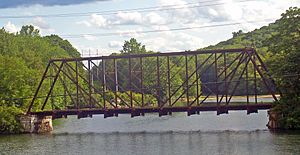Bridge L-158 facts for kids
Quick facts for kids Bridge L-158 |
|
|---|---|

View of Bridge L-158 from NY 138 to the north
|
|
| Coordinates | 41°17′47″N 73°40′58″W / 41.29639°N 73.68278°W |
| Carries | Abandoned NYCRR right-of-way |
| Crosses | Muscoot Reservoir |
| Locale | Goldens Bridge, New York, USA |
| Maintained by | New York City Department of Environmental Protection |
| Characteristics | |
| Design | Double-intersection Whipple truss |
| Material | Wrought iron |
| Total length | 163 feet (50 m) |
| Width | 16 feet (4.9 m) |
| Clearance below | 12 feet (3.7 m) |
| History | |
| Constructed by | Clarke, Reeves & Co.; North River Construction Co. |
| Construction end | 1883 |
| Opened | 1883 moved to current location in 1904 |
|
Bridge L-158
|
|
| Area | 1 acre (0.4 ha) |
| NRHP reference No. | 78001923 |
| Added to NRHP | November 29, 1978 |
| Lua error in Module:Location_map at line 420: attempt to index field 'wikibase' (a nil value). | |
Bridge L-158 is an old railroad bridge in New York. It crosses the Muscoot Reservoir near Goldens Bridge. This bridge was first built in 1883. It used to carry trains for the New York Central Railroad.
The bridge was moved to its current spot in 1904. In 1960, trains stopped using it and the tracks were removed. Bridge L-158 is special because it's the only double-intersection Whipple truss railroad bridge left in New York. In 1978, it was added to the National Register of Historic Places. This means it's an important historical site.
Where is Bridge L-158 Located?
The bridge is found over an inlet of the Muscoot Reservoir. This is about half a mile (1 km) west of the Goldens Bridge train station. It sits between the towns of Lewisboro and Somers.
You can see the bridge best from NY 138. This road crosses the reservoir about 500 feet (152 m) north of the bridge. You might also spot it through the trees from commuter trains.
The bridge is surrounded by forests. These lands are part of the reservoir's protected area. The New York City Department of Environmental Protection owns both the land and the bridge. You can still see where the old train tracks used to be on both sides of the bridge.
What is the Bridge Made Of?
Bridge L-158 is a truss bridge. A truss is a strong framework of connected parts. Both main truss parts are 163 feet (50 m) long. Each has nine identical sections. The main part of the bridge is 32 feet (10 m) deep.
Two concrete abutments hold up the bridge. These supports keep the bridge 12 feet (4 m) above the average water level. The top part of the bridge is made of wrought iron. This strong metal was shaped into special Phoenix columns.
The ends and top sections of the bridge have six flanged cast pieces. These are joined together with rivets. The middle vertical parts and side supports have four pieces each. The diagonal and bottom parts of the bridge use flat, rectangular eyebars. These are 4 to 6 inches (10 to 15 cm) wide. Round bars are used for other supports. The ties (the pieces of wood that hold the rails) sit on iron supports. These supports are riveted to iron floor beams. The entrances to the bridge are decorated with quatrefoil shapes and fancy finials.
History of Bridge L-158
This bridge was originally one of three spans. It was part of a very long bridge system. This system was 1,200 feet (366 m) long. It was built in 1883 near Kingston, about 50 miles (80 km) north.
The company Clarke, Reeves & Company built it. It was 29 feet (9 m) wide and had two tracks for trains. The railroad called it Bridge 141.
In 1904, the railroad built a new, bigger bridge in Kingston. At the same time, New York City was buying land. They were clearing and flooding areas to create a new water supply system. This was for the Croton River watershed. Railroads in the area had to build bridges over any new water areas. They had to pay for these bridges themselves.
So, the railroad decided to move Bridge 141. It became Bridge L-158 at its new location. It was perfect for crossing the new reservoir. The bridge was rebuilt to be 16 feet (5 m) wide. This was because the train line it would serve, the Mahopac Branch, only had one track.
Trains continued to use the Mahopac Branch until 1960. After that, the tracks were taken away. But the bridge itself stayed. In 1976, experts checked the bridge. They found it was still in good shape. This was true even though it hadn't been used or maintained for a while. The bridge is on protected land, which has helped keep it safe over the years.

